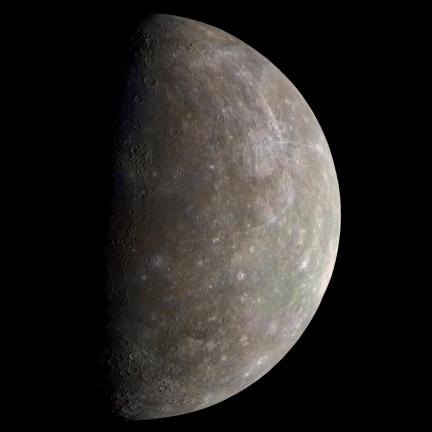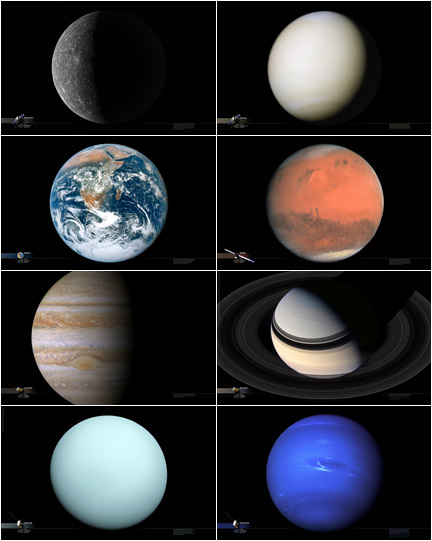 Today’s flyby will come as close as 200km from the surface. That is comparable to some of the close flybys of the Saturnian moons made by Cassini.
Today’s flyby will come as close as 200km from the surface. That is comparable to some of the close flybys of the Saturnian moons made by Cassini.
See here for Ted’s colorization of this image based upon his Mariner 10 work.
 Today’s flyby will come as close as 200km from the surface. That is comparable to some of the close flybys of the Saturnian moons made by Cassini.
Today’s flyby will come as close as 200km from the surface. That is comparable to some of the close flybys of the Saturnian moons made by Cassini.
See here for Ted’s colorization of this image based upon his Mariner 10 work.
 According to Ted Stryk (a regularly featured imager) this image has been under construction for over a year (higher resolution available here). If you are unaware, to date… no color images have seen the light of day from the 1973 Mariner 10 encounter. So it is with unexpected shock that we are granted this fine image from an old encounter the night before we are expected to be dazzled with a plethora of new Messenger images.
According to Ted Stryk (a regularly featured imager) this image has been under construction for over a year (higher resolution available here). If you are unaware, to date… no color images have seen the light of day from the 1973 Mariner 10 encounter. So it is with unexpected shock that we are granted this fine image from an old encounter the night before we are expected to be dazzled with a plethora of new Messenger images.
Although different missions are handled differently than others, we may not be granted all images as soon as they are received here on Earth. For example, Cassini has its images open almost immediately through the raw files link… while ESA makes us wait (and still does) while they release “official” images and other reports to the press. The Cassini method is far greater an option as freelance imagers will get color composites up and available hours after an encounter while you may wait weeks for the official imaging team to get around to making color composites for public consumption. I fear the latter will be true of Messenger (especially as Mercury is not expected to be an overly colorful place), but most US based planetary missions have been great about sharing the wealth practically in real time… hopefully Messenger follows the trend.
So enjoy this for now — as stated by JRehling at unmannedspaceflight, “The best Mercury image in mankind's history -- for another week.”
Nothing to show at this point (except some distant calibration images), but Messenger will arrive at Mercury on January 14th. This is the first visit to the tiniest planet since 1973. On that visit the Mariner spacecraft flew by the same region 3 different times — therefore leaving more than 50% of this planet yet unseen by human eyes. With the arrival of Messenger, most of what has not yet been imaged will be revealed in 2 more additional flybys and surely 100% will be revealed once Messenger achieves orbital insertion in 2011. With the exception of Pluto and its partner Charon, Mercury represents one of the largest pieces of real estate not yet mapped or imaged by some kind of probe in all our solar system.
 If I am going to keep making these things… I’d be a fool to not include a set for the Apple iPhone. Coincidentally, when you purchase your iPhone and do not yet have a phone service, the phone displays a full-disc image of the Earth pretty much displayed exactly as these do when uploaded to your iPhone. So in the spirit of continuity, you can now opt instead to have Mercury, Venus, Earth, The Moon (Luna), Mars, Jupiter, Io, Europa, Ganymede, Callisto, Saturn, Enceladus, Titan, Iapetus, Hyperion, Uranus, Miranda, Neptune or Triton grace your screen instead of the default Earth.
If I am going to keep making these things… I’d be a fool to not include a set for the Apple iPhone. Coincidentally, when you purchase your iPhone and do not yet have a phone service, the phone displays a full-disc image of the Earth pretty much displayed exactly as these do when uploaded to your iPhone. So in the spirit of continuity, you can now opt instead to have Mercury, Venus, Earth, The Moon (Luna), Mars, Jupiter, Io, Europa, Ganymede, Callisto, Saturn, Enceladus, Titan, Iapetus, Hyperion, Uranus, Miranda, Neptune or Triton grace your screen instead of the default Earth.
The easiest way to install wallpapers to your iPhone is to make a special set in iPhoto and simply drag all the files to that folder. Then in iTunes have your iPhone sync that folder to your photos collection. After that it is as simple as opening the “Photos” area of your iPhone. Go to your new folder of images and open whichever image you want. Then tap on the image just once and assign it as a wallpaper using the “Use as Wallpaper” button in the lower left corner of the screen.
If you have a PC I have no idea in hell how the hell you get images into your iPhone. I would buy a Mac… you have an iPhone and use iTunes… you are half-way there.
For a version of these with no graphics see this link.
The planets – the complete set for collectors! While there are literally thousands of images of the planets to choose from… full globe high resolution images are actually fairly rare. They usually require many exposures to be stitched together to make one large complete image. This is not only difficult to work out across the great distances of space, but also soaks up a large amount of valuable spacecraft time and energy. This set represents the best available images of each planet in our Solar System.

Sorry, no Pluto for more than one reason.
Sadly, Mercury has got to be the least interesting of the planets. It lacks any moons, lacks any substantial atmosphere and seems at a glance to be a duplicate of our own moon. At this point in time there has only been one mission to study Mercury up-close, Mariner 10 in 1973, so our information is quite limited. However, there is a mission on its way to Mercury right now named Messenger as well as a European/Japanese effort name Bepi-Columbo. Perhaps those missions will enlighten us all to things unseen on Mercury.
NOTE: This “portrait” wallpaper has been updated with a more recent color image taken during the January 2008 Messenger flyby.
No, its not our moon… its the planet Mercury. This is one of the best detailed images ever returned of Mercury and will likely remain so until Messenger reaches the planet in 2008 with an orbital insertion in 2011.